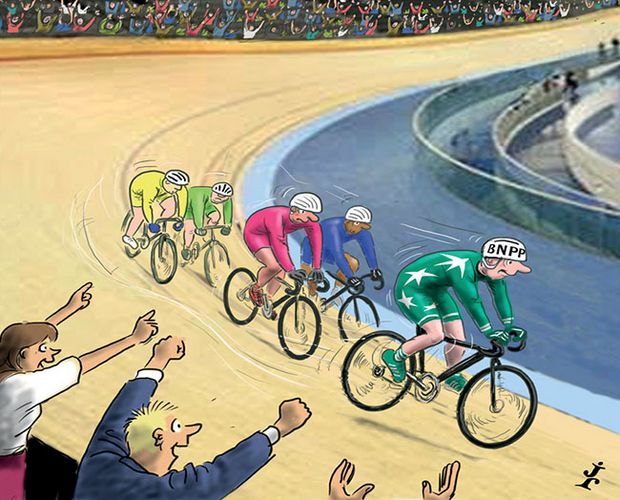Margin of difference
Hitting market themes, leading innovation and gaining market share may be aspirations held dear by many underwriting banks but they are frustratingly difficult to achieve. One bank managed just this in the euro market in 2016, however. BNP Paribas is IFR’s Euro Bond House of the Year.
For those at the top of their game, the difference between high achievement and dominant performance is small.
There is a concept in sport that success can be best realised by the aggregation of marginal gains – that a 1% improvement across every related area adds up to a significant overall advantage.
To be able to capitalise on this obviously requires being towards the front of the pack in the first place, though none could deny that BNP Paribas has consistently been a force to be reckoned with in the euro bond market.
“The last two years have been about consolidation; this year has been about getting the rewards,” said Martin Egan, global head of primary markets.
He highlighted the change to the bank’s platform, whereby primary and credit market activities were brought together under one management umbrella, which “reinforced true connectivity with our corporate client base, bringing bond and loan origination businesses together”, creating what the bank calls a credit continuum.
“There was a clear focus on marginal gain across all areas of activity, which, entwined with our corporate and institutional bank mantra of ‘focus, improve, grow’ has driven our primary markets strategy,” he said.
The results were plain to see, with BNPP claiming a seat at the top table across the various sectors. The sum of the parts made it the aggregate league table leader.
Such an outcome requires not only thorough and continual client coverage but also an understanding of the themes playing out throughout the year and the best way to address them.
The ECB and its various QE initiatives were front and centre of proceedings, not least in the SSAR sector, where the spectre of disappearing yields created a challenging backdrop.
One result was the emergence of ultra long-dated issuance from eurozone sovereigns, as they took advantage of the low rates on offer, while investors looked to book any returns they could.
BNPP acted as lead manager on the year’s first 50-year deal from France – which in tandem with a 20-year is IFR’s SSAR Bond of the Year – and also subsequent deals from Spain and Italy.
At the shorter end of the new issue market, the bank tempted investors to cross the Rubicon into negative yield territory with Finland’s €3bn seven-year at the end of August. The bank’s credentials in the sub-zero sphere had already been set in the supranational arena at the start of the year through a three-year from the EIB.
This central bank-inspired narrative was repeated in the corporate sector, and again BNPP was at the forefront, lead-managing negative-yielding deals from Sanofi and Henkel on the same day.
It was also in the vanguard of championing the euro market when it came to large multi-tranche deals, often M&A-related, for the likes of Anheuser-Busch InBev and Teva, and subsequently Air Liquide and Danone, even when the acquisition currency was US dollars.
“It showed what’s do-able in the euro market in terms of size,” said Fred Zorzi, global head of bond and loan syndicate. It also underscored the “integrated, unbiased service” facilitated by the amalgamation of the loan and bond initiatives. “We already had long-term relationships; it was about offering a better service,” he said.
BNPP was also instrumental in providing market access to the mid-cap corporate community.
“It’s not just about large deals but also debut and smaller issuers,” said Renaud Franck-Falce, head of corporate debt platform EMEA, highlighting inaugural deals for unrated Ferrari and Ipsen.
Add to this a principal role in such thematic events as reverse Yankee issuance and leadership at times of uncertainty – for example, around the introduction of the ECB’s corporate bond-buying programme, the UK’s EU referendum and the US election – and it makes for a winning formula, for which BNPP was named IFR’s Europe Investment-Grade Bond House.
This leadership was also visible in the financials sector, where the bank was a guiding light in much that was innovative, such as Nykredit’s senior resolution notes (IFR’s Euro Bond of the Year), ING Bank’s T2 “flipper” bond (whereby the issuing entity could be switched to ING Groep), CNP Assurance’s T3 (the first from an insurance company in euros) and SMFG’s TLAC-eligible transaction (the first such from Asia).
BNPP was also dominant in the funding market, be it in covered bonds, when they were the instrument of choice, or senior unsecured issuance.
The bank was busy throughout the year, relying on its market read to deliver, even at times that the more conservative might have considered courageous – such as a dual-tranche trade for Royal Dutch Shell at the height of the summer holiday season in August or a number of transactions priced on Fridays, generally not a day associated with issuance.
Its audacious yet considered approach maximised opportunities for its clients, the corollary being a best-in-class franchise. A winning mix indeed.
To see the digital version of this review, please click here.
To purchase printed copies or a PDF of this review, please email gloria.balbastro@tr.com



